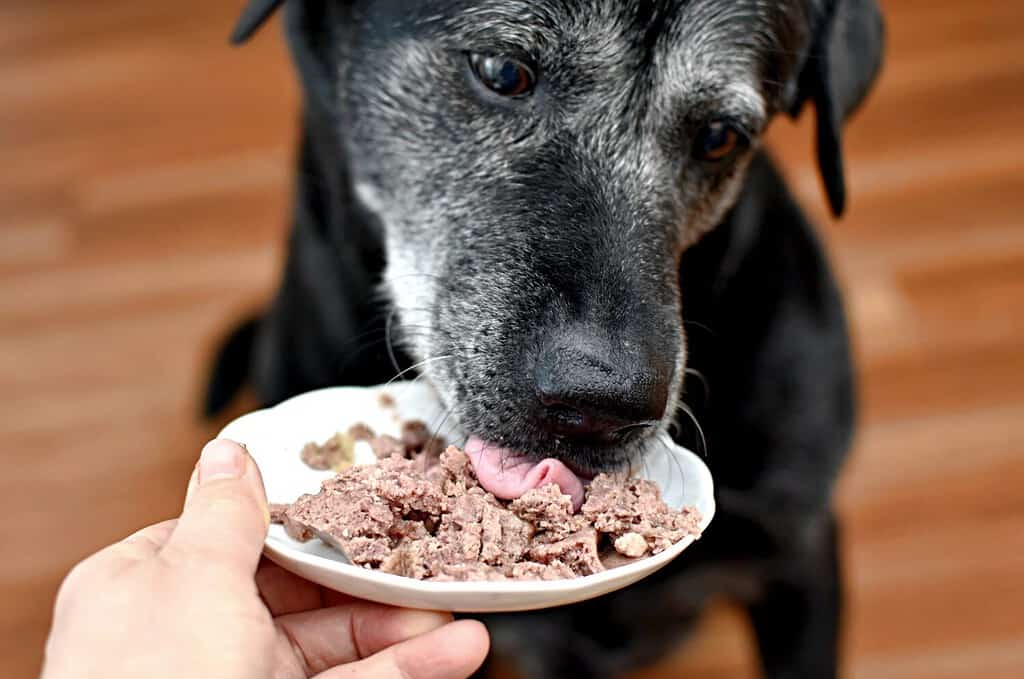Pet guardians are becoming more informed than ever about what their dogs are eating. This is an excellent thing, and I have high hopes that it’ll push dog food companies to provide better for our pups.
However, this has also led to a ton of misinformation being spread. It can be difficult to know who to listen to and what’s actually healthy for your dog.
One example is raw treats like chicken feet. You might have been told your dog shouldn’t eat chicken bones, and now you’re seeing influencers feeding chicken feet to their dogs–so, can dogs really have chicken feet after all?
The simple answer is no. Dogs shouldn’t eat chicken feet.
Chicken feet contain nutrients that support joint health, and can help dogs’ teeth stay clean. However, they’re not the best way to achieve either of those things, because feeding chicken feet also comes with huge risks. Cooked bones can splinter, while raw chicken feet can contain harmful bacteria, including Salmonella, Listeria, and Campylobacter.
Feeding raw food to your dog can harm not only them, but the rest of your family. It can be difficult to stop a dog treat from touching various surfaces in your home, leaving them potentially infected.
In this article, we’ll talk more about why your dog shouldn’t eat chicken feet, the risks and benefits, and some alternatives.
Are Chicken Feet Healthy for Dogs?

Although dogs love chewing on bones, sometimes this can be quite dangerous depending on the type and size of the bone.
©iStock.com/K_Thalhofer
In theory, chicken feet come with several health benefits and would be good for dogs to eat–if they didn’t also come with so many risks.
Cooked chicken bones of any kind are unsafe to feed, as they become brittle and can splinter easily inside of your dog’s body. This can lead to tears in your dog’s digestive system.
Raw chicken feet won’t splinter like this, but they come with other risks. Uncooked chicken frequently contains dangerous bacteria, including Salmonella, Campylobacter, and Listeria.
Your dog isn’t the only one potentially at risk when they eat chicken feet, either. Other pets and family members who come into contact with the chicken feet or infected surfaces can also get sick.
So if your dog carries their treats to their bed and then your child lays in the bed to snuggle them, or they drop the treat on the floor and the cat later walks by, or even if your dog licks your face after eating their treat–these can all cause people and animals other than your dog to become infected.
Risks of Chicken Feet for Dogs
Raw Chicken Feet can Make your Dog Sick
Because cooked chicken feet can splinter, raw chicken feet are what is typically fed to dogs. However, this puts your dog and everyone else in the household at risk of Salmonella, Campylobacter, and Listeria infections. These bacteria are all commonly present in uncooked chicken.
Though raw diets and treats are trendy right now, both the Federal Department of Agriculture (FDA) and the American Veterinary Medical Association are against feeding raw meat to your pets.
The FDA cites the risk not only to dogs, but to humans as well. They note that your hands and any surfaces touched by raw meat must be cleaned and disinfected after preparing raw foods for your dog.
Keep in mind that this includes if the treat touches your clothes, your dog’s bed, the floor, etc. And disinfecting surfaces will only help prevent you and your family from becoming sick from contaminated meat–but your dog, who’s eating it, is still at risk of getting sick.
Cooked Chicken Feet are Difficult to Digest

Cooked chicken bones splinter easily.
©kalyanby/Shutterstock.com
It’s easy enough to think that while raw chicken feet are dangerous, they’d be okay if cooked. However, this isn’t true.
Cooked chicken bones splinter easily. They can cut your dog on their way through the digestive system, potentially causing ruptures or infections.
Benefits to Chicken Feet for Dogs
Can Help Maintain Dental Health
Proponents of raw chicken feet will say that they help to maintain a dog’s dental health–and they do! Chewing on bones is good for dogs’ teeth, and it’s the only way wild wolves have to keep their teeth clean.
However, we have better options for maintaining our dogs’ dental health that don’t come with the above risks.
These include brushing your dog’s teeth daily, offering safe dental treats approved by the Veterinary Oral Health Council, and visiting the veterinarian for dental care as needed.
Contains Nutrients to Support Joint Health
Chicken feet also contain nutrients such as glucosamine and chondroitin that support joint health in dogs. These nutrients are especially beneficial to large breeds prone to joint problems, seniors, and dogs with arthritis.
Fortunately, there are safe ways to provide our dogs with these supplements without feeding them chicken feet.
The easiest way to give your dog these nutrients is by purchasing a supplement that contains them.
If your dog is suffering from arthritis or other joint pain, please also see your veterinarian. They can suggest not only supplements but also pain medications and other treatments to help your dog live comfortably.
What Is the Healthiest Meat for Dogs?

There are some good and bad meat choices for your beloved pet’s diet.
©Pommer Irina/Shutterstock.com
While we are talking about whether or not dogs can handle chicken feet, why don’t we jump into what type of meat is the best option for man’s best friend?
This probably should not come as too much surprise, but generally, the meats that are best for us as humans are on top of the list for canines.
Chicken is a great option for dogs because it is lean and low in fat. It is also not as expensive as some other meats out there, like lamb.
Another really solid option is to feed your pup salmon as a meat choice. Salmon works to reduce inflammation, which is great for older dogs, and this fish product provides a source of omega fatty acids that have many benefits. On top of all that, salmon contains many vitamins to also help your dogs diet.
The photo featured at the top of this post is © Mironov Vladimir/Shutterstock.com
Ready to discover the top 10 cutest dog breeds in the entire world?
How about the fastest dogs, the largest dogs and those that are -- quite frankly -- just the kindest dogs on the planet? Each day, AZ Animals sends out lists just like this to our thousands of email subscribers. And the best part? It's FREE. Join today by entering your email below.
Thank you for reading! Have some feedback for us? Contact the AZ Animals editorial team.






